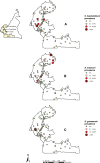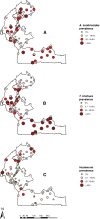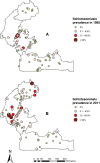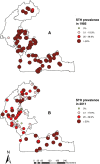Mapping of schistosomiasis and soil-transmitted helminthiasis in the regions of Littoral, North-West, South and South-West Cameroon and recommendations for treatment
- PMID: 24365046
- PMCID: PMC3878270
- DOI: 10.1186/1471-2334-13-602
Mapping of schistosomiasis and soil-transmitted helminthiasis in the regions of Littoral, North-West, South and South-West Cameroon and recommendations for treatment
Abstract
Background: The previous nationwide mapping of schistosomiasis and soil-transmitted helminthiasis (STH) in Cameroon was conducted 25 years ago. Based on its results, mass drug administration (MDA) of praziquantel was limited to the three northern regions and few health districts in the southern part of Cameroon. In 2010, we started the process of updating the disease distribution in order to improve the control strategies. Three of the ten regions of Cameroon were mapped in 2010 and the data were published. In 2011, surveys were conducted in four additional regions, i.e. Littoral, North-West, South and South-West.
Methods: Parasitological surveys were conducted in March 2011 in selected schools in all 65 health districts of the four targeted regions, using appropriate research methodologies, i.e. Kato-Katz and urine filtration.
Results: The results showed significant variation of schistosomiasis and STH prevalence between schools, villages, districts and regions. Schistosoma haematobium was the most prevalent schistosome species, with an overall prevalence of 3.2%, followed by S. mansoni (3%) and S. guineensis (1.2%). The overall prevalence of schistosomiasis across the four regions was 7.4% (95% CI: 6.7-8.3%). The prevalence for Ascaris lumbricoides was 19.5% (95% CI: 18.3-20.7%), Trichuris trichiura 18.9% (95% CI: 17.7-20.1%) and hookworms 7.6% (95% CI: 6.8-8.4%), with an overall STH prevalence of 32.5% (95% CI: 31.1-34.0%) across the four regions. STH was more prevalent in the South region (52.8%; 95% CI: 48.0-57.3%), followed by the South-West (46.2%; 95% CI: 43.2-49.3%), the North-West (35.9%; 95% CI: 33.1-38.7%) and the Littoral (13.0%; 95% CI: 11.3-14.9%) regions.
Conclusions: In comparison to previous data in 1985-87, the results showed an increase of schistosomiasis transmission in several health districts, whereas there was a significant decline of STH infections. Based on the prevalence data, the continuation of annual or bi-annual MDA for STH is recommended, as well as an extension of praziquantel in identified moderate and high risk communities for schistosomiasis.
Figures




Similar articles
-
Mapping of schistosomiasis and soil-transmitted helminthiasis in the regions of centre, East and West Cameroon.PLoS Negl Trop Dis. 2012;6(3):e1553. doi: 10.1371/journal.pntd.0001553. Epub 2012 Mar 6. PLoS Negl Trop Dis. 2012. PMID: 22413029 Free PMC article.
-
National mapping of soil-transmitted helminth and schistosome infections in Ethiopia.Parasit Vectors. 2020 Sep 1;13(1):437. doi: 10.1186/s13071-020-04317-6. Parasit Vectors. 2020. PMID: 32873333 Free PMC article.
-
Precision and geographical prevalence mapping of schistosomiasis and soil-transmitted helminthiasis among school-aged children in selected districts of north-western Tanzania.Parasit Vectors. 2022 Dec 29;15(1):492. doi: 10.1186/s13071-022-05547-6. Parasit Vectors. 2022. PMID: 36581956 Free PMC article.
-
Soil-transmitted helminths and schistosome infections in Ethiopia: a systematic review of progress in their control over the past 20 years.Parasit Vectors. 2021 Feb 5;14(1):97. doi: 10.1186/s13071-021-04600-0. Parasit Vectors. 2021. PMID: 33546757 Free PMC article.
-
Mapping schistosomiasis risk in Southeast Asia: a systematic review and geospatial analysis.Int J Epidemiol. 2023 Aug 2;52(4):1137-1149. doi: 10.1093/ije/dyac227. Int J Epidemiol. 2023. PMID: 36478466
Cited by
-
Precision mapping: An innovative tool and way forward to shrink the map, better target interventions, and accelerate toward the elimination of schistosomiasis.PLoS Negl Trop Dis. 2018 Aug 2;12(8):e0006563. doi: 10.1371/journal.pntd.0006563. eCollection 2018 Aug. PLoS Negl Trop Dis. 2018. PMID: 30071014 Free PMC article. No abstract available.
-
Morphological identification of hookworm species in five regions of Cameroon.Helminthologia. 2024 Dec 12;61(3):224-231. doi: 10.2478/helm-2024-0025. eCollection 2024 Sep. Helminthologia. 2024. PMID: 39679330 Free PMC article.
-
Knowledge, attitudes and practices regarding urinary schistosomiasis among adults in the Ekombe Bonji Health Area, Cameroon.Pan Afr Med J. 2018 Mar 19;29:161. doi: 10.11604/pamj.2018.29.161.14980. eCollection 2018. Pan Afr Med J. 2018. PMID: 30050625 Free PMC article.
-
Small bowel obstruction complicating an Ascaris lumbricoides infestation in a 4-year-old male: a case report.J Med Case Rep. 2019 May 24;13(1):155. doi: 10.1186/s13256-019-2103-y. J Med Case Rep. 2019. PMID: 31122293 Free PMC article.
-
Prevalence, correlates of undernutrition and intestinal parasitic infection among children below 5 years living in the forest community of Ndelele, East Region of Cameroon: A cross-sectional assessment.PLoS One. 2022 Dec 8;17(12):e0278333. doi: 10.1371/journal.pone.0278333. eCollection 2022. PLoS One. 2022. PMID: 36480502 Free PMC article.
References
-
- Kane RA, Southgate VR, Rollinson D, Littlewood DT, Lockyer AE, Pages JR, Tchuem Tchuente LA, Jourdane J. A phylogeny based on three mitochondrial genes supports the division of Schistosoma intercalatum into two separate species. Parasitology. 2003;13(2):131–137. doi: 10.1017/S0031182003003421. - DOI - PubMed
-
- Pagès JR, Jourdane J, Southgate VR, Tchuem Tchuenté LA. In: Taxonomy, Ecology and Evolution of Metazoan Parasites. Volume 2. Combes C, Jourdane J, editor. Perpignan: Presses Universitaires de Perpignan; 2003. Reconnaissance de deux espèces jumelles au sein du taxon Schistosoma intercalatum Fisher, 1934, agent de la schistosomose humaine rectale en Afrique. Description de Schistosoma guineensis n. sp.
-
- Ratard RC, Kouemeni LE, Bessala MM, Ndamkou CN, Greer GJ, Spilsbury J, Cline BL. Human schistosomiasis in Cameroon. I. Distribution of schistosomiasis. Am J Trop Med Hyg. 1990;13(6):561–572. - PubMed
Publication types
MeSH terms
Substances
LinkOut - more resources
Full Text Sources
Other Literature Sources

